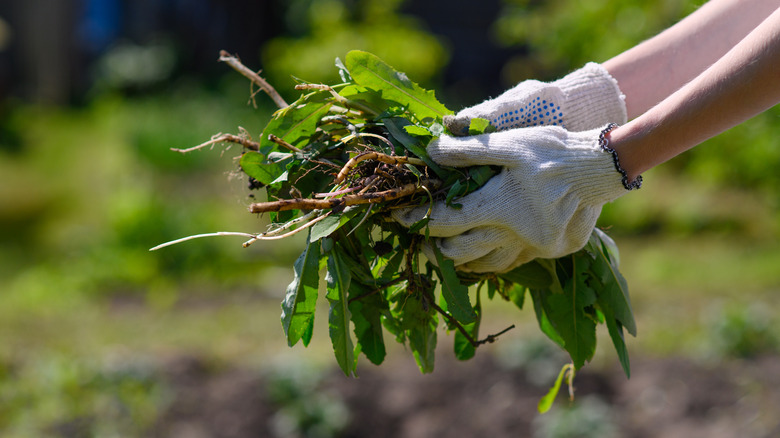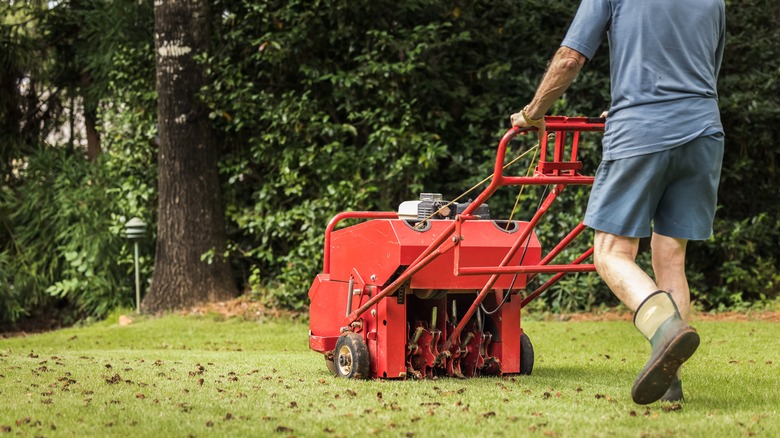In 17th Century Europe, neatly mowed turf emerged as a status symbol among wealthy landowners, explains Planet Natural. The areas around their mansions were carefully landscaped by teams of gardeners, and this trend directly influenced the design of town and city parks that began to spring up during the Industrial Revolution. It wasn’t long before middle-class homeowners wanted their own little patch of park, and thus, the American obsession with lawns was born.
According to Landscape East & West, in 2011, Americans spent over $8.5bn maintaining their grassy yards, mowing an area as large as the state of Pennsylvania. Lawn care is big business, but spending extra money or time on your lawn doesn’t guarantee green grass. Furthermore, there are more and more challenges facing lawn lovers. Water shortages across drier states, concerns about biodiversity, pollinators, and runoff, as well as ordinances against noisy landscaping tools, have all damaged the reputation of lawns in recent years. However, many neighborhood associations continue to stipulate that residents maintain a neat and tidy lawn. So, how can you keep your lawn looking lush and natural without it costing the Earth?
The perfect grass species

If you can plant grass in its preferred type of soil, it will develop a healthy root system and with it better resilience to changes in the levels of water and nutrients in the soil. Although well-kept lawns look almost identical, there is a wide range of grass species to choose from. Each variety has its own preferences in terms of soil, temperature, water levels, and some specialist adaptations — such as salt resistance for coastal gardens.
Lawns that thrive in the Northern U.S. and Canada would turn into brown patchwork doormats in the warmer climates of the South. There are several options for grasses that grow well in the heat: carpetgrass grows well in wet, acidic soils; bahiagrass enjoys sandier soil, and tall fescue grass can deal much better with heavy clays. Just like any plant, different grasses are adapted to different levels of sunlight exposure — they can get scorched or shaded to death if planted in the wrong situation.
Rather than focusing on the potential pitfalls though, this means there is a perfect grass species for your lawn out there — once you discover your niche, you’ve just got to find the type of grass that fits it.
Watering, when and where?

Watering lawns is often in the headlines as the global need to conserve water intensifies. Part of the problem is that people overwater their lawns. According to Deseret News, nearly half of Utahans use too much water on their lawns in an effort to keep their lawns healthy. Not only is this a waste of water, but it is also bad for grass. Daily watering encourages sensitive, shallow roots.
The average lawn only needs watering 2 to 3 times a week in summer months and 1 or 2 times a week in cooler times. This will encourage the roots to grow deeper and healthier, as well as provide protection against fungal growth — another risk for lawns that are watered too often. The absolute best watering routine for a green lawn is enough water to soak 6 inches into the soil, once or twice a week, before 10 in the morning — if you can set up a system to do that automatically for you, all the better!
Mowing methods

tommaso79/Shutterstock
Lawn care is not evenly distributed throughout the year. The winter is pretty dormant, but the summer can feel like a constant battle with your lawn as it grows quickly. There is an understandable temptation to mow the grass harder and lower in order to give yourself more time between each mow, especially if you have a large area of property to manage. However, this would be a mistake.
Letting your lawn grow a little longer and maintaining a generous blade height is the key to helping your grass stay lush and healthy through the summer months. Let the grass grow to 4 or 4 1/2 inches high, and then mow to around 3 inches high and repeat throughout the season. The extra biomass shades and cools the ground, preserving water and preventing overheating. Short mowing runs the risk of exposing the roots to the intense summer heat and can turn a lush lawn brown very quickly.
Another common oversight is the blades of the mower itself. Mower blades ought to be sharpened after every 25 hours of mower use. That could be once a year or a few times a month, depending on how much lawn you’ve got to take care of! Blunt blades don’t cut grass, they tear and rip it, which looks unsightly and puts your lawn at risk of disease.
Use organic fertilizer

The Toidi/Shutterstock
Plants, like people, need a complex mix of micro- and macro-nutrients to function healthily and well. They pull most of these chemicals from the soil via their root system. The level of these chemicals present in the soil goes down slightly with every inch of grass grown, and with every inch of water that washes through the soil. It’s critical, therefore, to replenish your soil regularly so that your lawn can continue to grow with strength and vigor.
Inorganic fertilizers are chemically-produced compounds that contain plant nutrients in various quantities — but there is often a lot more phosphorus in these mixes than grass really needs to grow in a healthy way. This excess can have negative unintended consequences for local flora and fauna.
A more natural way to fertilize your lawn for green growth throughout the year is to use slow-release organic fertilizer. This isn’t absorbed by the grass but is broken down by organisms in the soil into the perfect blend of nutrients for the grass. Because this is an ongoing process you only need to apply an organic fertilizer to your lawn once or twice a year and it will provide a constant source of nutrients. Exactly when to fertilize your lawn will depend on your location, but it’s best to wait until your soil temperature is above 55 degrees as a rule of thumb.
Pull out all weeds by hand

Nikita Burdenkov/Shutterstock
Pulling weeds by hand is a great natural way to keep your lawn green. It allows you to specifically target and remove any unwanted plants, preventing them from competing with your grass for nutrients, water, and sunlight, which can rob it of its color. This targeted approach helps to maintain the overall health of your lawn, allowing the grass to thrive and establish a stronger root system. Plus, hand-pulling eliminates the need for chemical herbicides, which can leak into the soil and potentially contaminate water sources. By opting for manual removal, you minimize the risk of introducing harmful substances into the ecosystem and safeguard the well-being of beneficial organisms like insects and birds that contribute to a healthy, green lawn.
In addition, hand-pulling weeds provides an opportunity to engage with your lawn on a more intimate level. It allows you to closely observe the condition of your grass, identify potential issues, and address them promptly, which means things will stay greener, longer. You will be able to tell if there are any diseases or pest infestations present, which can be treated before they escalate. To get rid of weeds, moisten the soil to make removal easier. Use a small hand tool or a weed-pulling tool to get a firm grip on the weed’s base. Gently but firmly pull upwards, ensuring that you remove the entire root system to prevent regrowth. Dispose of the pulled weeds properly to prevent them from reseeding or spreading.
Avoid compacted soil by aerating

The Toidi/Shutterstock
Avoiding compacted soil will keep your lawn healthy and green. One way to do this is through lawn aeration. Just like it sounds, soil compaction occurs when the soil particles become too densely packed. This restricts the flow of air, water, and nutrients to the roots. This can lead to shallow root growth, poor drainage, and an overall decline in the lawn’s health, causing it to turn brown. Aeration involves the process of creating small holes in the soil, allowing for better air and water circulation and promoting deeper root development. You can do this by hand or with a machine.
By aerating your lawn, you can improve the overall soil structure and reduce compaction, enabling your lawn’s roots to access the necessary oxygen, water, and nutrients they require for optimal growth. This enhanced root development leads to a more robust and resilient turf that can withstand stressors like extreme heat, drought, and heavy foot traffic. Plus, aeration promotes the breakdown of thatch, a layer of dead organic matter that accumulates on the surface of the soil. Excessive thatch prevents water from penetrating the soil and can create an environment conducive to disease and pest problems. By creating a pathway for water to reach the root zone, aeration helps prevent thatch buildup and creates a green lawn.
Introduce integrated pest management

Serenko Natalia/Shutterstock
Integrated pest management (IPM) is a comprehensive lawn care approach that focuses on maintaining a green and healthy lawn by effectively managing pests without having to rely on excessive chemical treatments. This system involves monitoring and identifying pest populations, understanding their life cycles and habits, and using targeted control methods to remove them as they crop up.
This means IPM is not just about squashing bugs, but rather a part of a larger natural lawn care strategy. You essentially sit back and let the “good guys” like birds and certain types of insects like bees do the heavy lifting in lawn care for you. When unwanted pests that might kill your grass (like grubs) arrive, you can act swiftly to get rid of them. However, the key is to make your lawn attractive to beneficial visitors by adding things like birdfeeders and flowers, so the “bad guys” don’t have a chance to show up in the first place.



